04/01/2011
The March 2011 monthly unemployment figures show the official unemployment rate decreased to 8.8% and the total jobs gained were 216,000, with 28,800 of those jobs being private temporary. Total private jobs came in at +230,000 with government jobs dropping -14,000.

Those entering not in the labor force dropped by -11,000. The labor force participation rate was unchanged, 64.2%, the same as the previous two months. Those added to the civilian labor force was +160,000 and to the noncivilian population, +149,000. This is the lowest labor participation rate since March 1984. U6, or the broader unemployment measurement, dropped -0.2% to 15.7%.
Below is the nonfarm payroll, the total number of jobs, seasonally adjusted. Since the start of the great recession, declared by the NBER to be December 2007, the United States has officially lost 7.245 million jobs. That does not take into account additional jobs needed to employ the United States increased population, but does include the jobs added over the over 3 year time period.
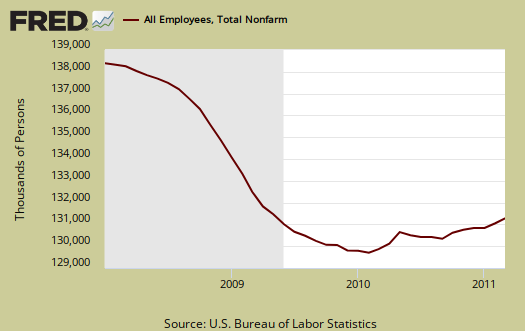
Below is a running tally of how many official jobs permanently lost since the official start of this past recession (recall the private NBER has declared the recession over!). This is a horrific tally and notice this isn't taking into account increased population growth, which implies the United States needs to create at least 10.5 million jobs to break even from December 2007.
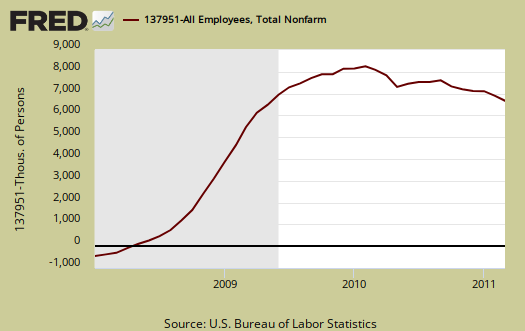
We get a new graph of the alternative unemployment measurement, U-6, posted below. Here you can see the incredible increase in comparison to the beginning of this broader unemployment measurement.
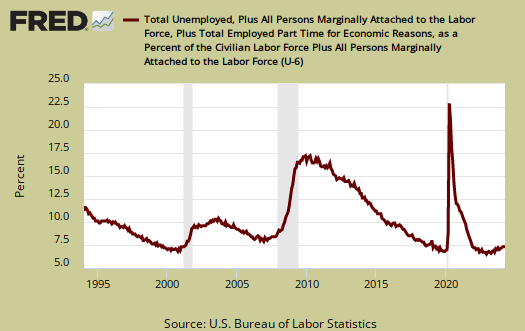
How can the unemployment rate decrease? Because there were 216,000 jobs plus noncivilian non-institutional population was only 149,000 this month, which is a monthly growth deceleration. Below is an annualized graph of civilian institutional population. We see a deceleration of population growth. It's from this category of people that potential workers come from.
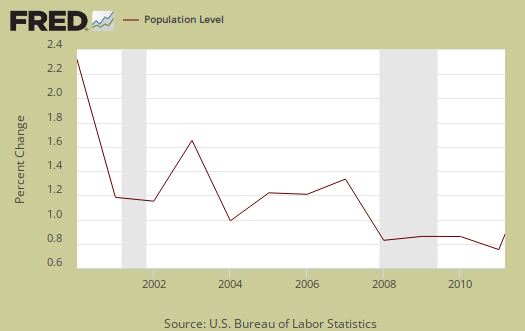
The population to employed ratio increased 0.1%. We finally had enough jobs created to go past the monthly increased of the civilian labor force, plus the estimates for non-institutional civilian population monthly growth have significantly reduced and non-institutional civilian population is the super set of potential workers.
The civilian labor force increased by +160,000. Of those still in the civilian labor force, employed, increased by 291,000 in March, yet those unemployed dropped by -131,000. Those not in the labor force dropped by -11,000 in a month.
The civilian non-institutional population are those 16 years or older not locked up somewhere or not in the military or so sick and disabled they are in a nursing home and so on.
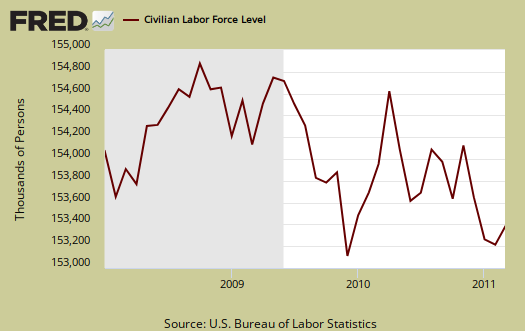
The increasingly low labor participation rate is now at 64.2%. If we go back to December 2007, the labor participation rate was 66%. The highest civilian labor participation rate was in January 2000, at 67.3%. What this means is there are almost 4.25 million people not be accounted for in the official unemployment rate who probably need a job and can't find one.
\small \text (03/11 Civilian Population) * (\text 12/07 labor participation rate - \text 03/12 labor participation rate) :
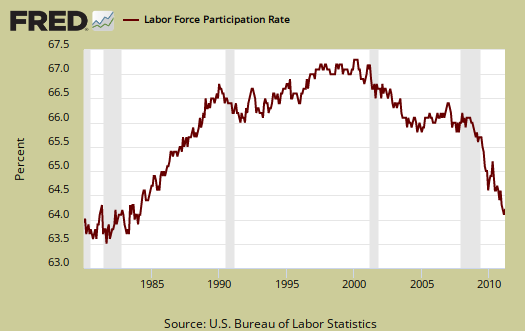
The employment to population ratio is now 58.5% which is 0.1% point above record lows. This isn't a structural change, such as all families decided to have a stay at home caretaker, or magically a host of people could retire early, this is people dropping out of the count.
These numbers are important because unemployment is a ratio, percentage or during a limited time period, the number of people actively looking for a job and counted. Many people are not counted in the official unemployment statistics, due to definitions, but obviously when one has more potential workers and less jobs, that metric doesn't bode well for America.
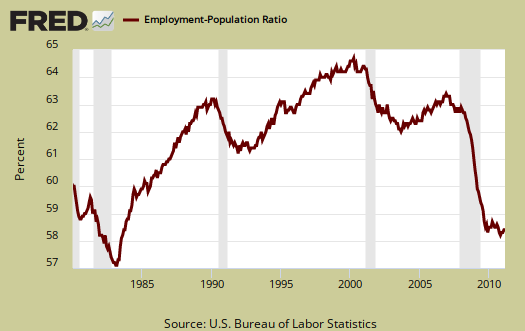
Below is the graph of the civilian non-institutional population, which is the largest super-set of the potential labor force, larger than the civilian workforce, due to those who are not looking for work, retired and so on being counted in this figure. This is why one must create jobs greater than the constant rate of jobs lost. There are more people to employ. Unemployment is a percentage, a ratio.
The BLS unemployment report counts foreign temporary guest workers as well as illegal immigrants in their U.S. labor force statistics.
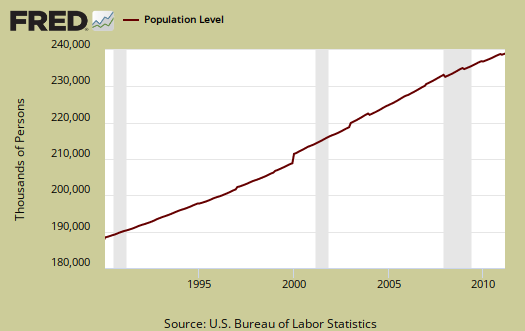
One needs at least 175,000 and some estimate up to 375,000 permanent full time jobs, added each month just to keep pace with U.S. civilian workforce population growth. That's not general population, that's the group needing a job.
While this report now gives two months of solid job growth, bear in mind it's not enough. Don't let the press or the politicians trying to blind you into thinking America doesn't have a jobs crisis.
The March 2011 monthly unemployment figures show the official unemployment rate decreased to 8.8% and the total jobs gained were 216,000, with 28,800 of those jobs being private temporary. Total private jobs came in at +230,000 with government jobs dropping -14,000.

Those entering not in the labor force dropped by -11,000. The labor force participation rate was unchanged, 64.2%, the same as the previous two months. Those added to the civilian labor force was +160,000 and to the noncivilian population, +149,000. This is the lowest labor participation rate since March 1984. U6, or the broader unemployment measurement, dropped -0.2% to 15.7%.
Below is the nonfarm payroll, the total number of jobs, seasonally adjusted. Since the start of the great recession, declared by the NBER to be December 2007, the United States has officially lost 7.245 million jobs. That does not take into account additional jobs needed to employ the United States increased population, but does include the jobs added over the over 3 year time period.

Below is a running tally of how many official jobs permanently lost since the official start of this past recession (recall the private NBER has declared the recession over!). This is a horrific tally and notice this isn't taking into account increased population growth, which implies the United States needs to create at least 10.5 million jobs to break even from December 2007.

We get a new graph of the alternative unemployment measurement, U-6, posted below. Here you can see the incredible increase in comparison to the beginning of this broader unemployment measurement.

How can the unemployment rate decrease? Because there were 216,000 jobs plus noncivilian non-institutional population was only 149,000 this month, which is a monthly growth deceleration. Below is an annualized graph of civilian institutional population. We see a deceleration of population growth. It's from this category of people that potential workers come from.

The population to employed ratio increased 0.1%. We finally had enough jobs created to go past the monthly increased of the civilian labor force, plus the estimates for non-institutional civilian population monthly growth have significantly reduced and non-institutional civilian population is the super set of potential workers.
The civilian labor force increased by +160,000. Of those still in the civilian labor force, employed, increased by 291,000 in March, yet those unemployed dropped by -131,000. Those not in the labor force dropped by -11,000 in a month.
The civilian non-institutional population are those 16 years or older not locked up somewhere or not in the military or so sick and disabled they are in a nursing home and so on.

The increasingly low labor participation rate is now at 64.2%. If we go back to December 2007, the labor participation rate was 66%. The highest civilian labor participation rate was in January 2000, at 67.3%. What this means is there are almost 4.25 million people not be accounted for in the official unemployment rate who probably need a job and can't find one.
\small \text (03/11 Civilian Population) * (\text 12/07 labor participation rate - \text 03/12 labor participation rate) :

The employment to population ratio is now 58.5% which is 0.1% point above record lows. This isn't a structural change, such as all families decided to have a stay at home caretaker, or magically a host of people could retire early, this is people dropping out of the count.
These numbers are important because unemployment is a ratio, percentage or during a limited time period, the number of people actively looking for a job and counted. Many people are not counted in the official unemployment statistics, due to definitions, but obviously when one has more potential workers and less jobs, that metric doesn't bode well for America.

Below is the graph of the civilian non-institutional population, which is the largest super-set of the potential labor force, larger than the civilian workforce, due to those who are not looking for work, retired and so on being counted in this figure. This is why one must create jobs greater than the constant rate of jobs lost. There are more people to employ. Unemployment is a percentage, a ratio.
The BLS unemployment report counts foreign temporary guest workers as well as illegal immigrants in their U.S. labor force statistics.

One needs at least 175,000 and some estimate up to 375,000 permanent full time jobs, added each month just to keep pace with U.S. civilian workforce population growth. That's not general population, that's the group needing a job.
While this report now gives two months of solid job growth, bear in mind it's not enough. Don't let the press or the politicians trying to blind you into thinking America doesn't have a jobs crisis.


 MAKE SURE AND VISIT Tobee's Blogs!
MAKE SURE AND VISIT Tobee's Blogs! 

Comment